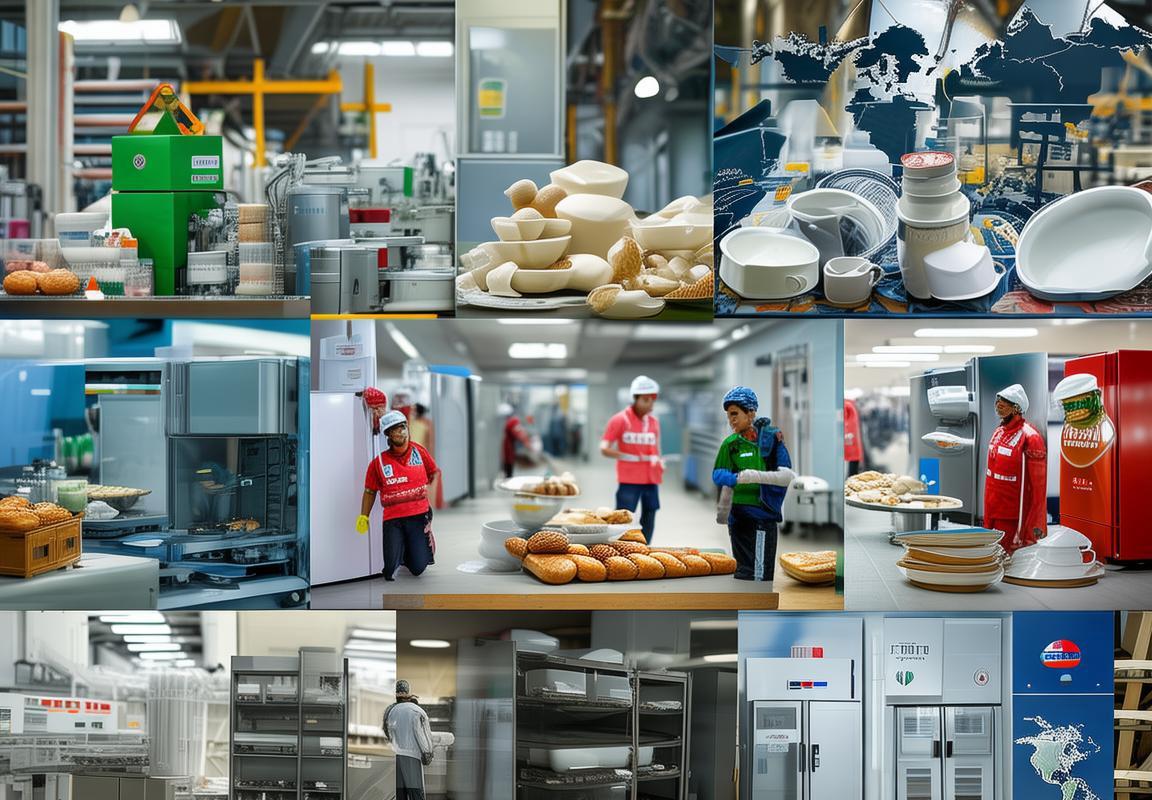In the ever-evolving landscape of the kitchen appliance industry, a significant trend has emerged: the rise of import substitution programs. These initiatives are reshaping markets in Europe and the United States, challenging the dominance of foreign brands and fostering a new wave of domestic production. This shift is driven by a combination of economic, political, and consumer-driven factors, each playing a pivotal role in the current state of the kitchen appliance markets. As we delve into the intricacies of this transformation, it becomes clear that the road ahead is fraught with opportunities and challenges, shaping the future of the global kitchen appliance trade.
Introduction to Import Substitution Programs
Import substitution programs have been a pivotal strategy in the economic development of many countries, aiming to reduce dependence on foreign imports by promoting domestic production. These programs, which gained prominence in the mid-20th century, were particularly influential in Latin America and Asia. At their core, import substitution programs sought to protect and nurture local industries by imposing tariffs, quotas, or other trade barriers on foreign goods, thereby encouraging the growth of domestic alternatives.
The concept of import substitution was born out of the desire to break free from the economic dominance of colonial powers and to foster national self-sufficiency. By focusing on the production of goods that were previously imported, countries hoped to create jobs, stimulate economic growth, and build a strong industrial base. Over time, these programs took on various forms, ranging from import substitution industrialization (ISI) to strategic import substitution.
One of the key principles of import substitution was the idea of prioritizing domestic production over foreign imports. This was often achieved through the implementation of protective measures such as tariffs, which made imported goods more expensive, and quotas, which limited the quantity of imports allowed into the country. By making domestic products more competitive, these measures were intended to encourage consumers to choose locally produced goods.
The historical context of import substitution programs is marked by the Cold War era, when many countries were looking for ways to align their economies with their political ideologies. For example, in Latin America, countries like Argentina, Brazil, and Mexico embraced import substitution as a means to create a more balanced and self-reliant economy, free from the whims of international trade and the influence of foreign corporations.
In the European context, the post-World War II period saw a similar trend, with countries like Italy and France implementing import substitution programs to rebuild their economies and reduce their vulnerability to external shocks. These programs were often supported by state intervention, with governments playing an active role in fostering domestic industries.
Despite their intentions, import substitution programs were not without their challenges. One of the most significant drawbacks was the potential for inefficiency and lack of competitiveness. When protected from international competition, domestic industries might not have the incentive to innovate or improve their production processes. This could lead to higher costs, lower quality, and a lack of variety in the market.
Moreover, import substitution programs could create trade imbalances, as countries became less open to international trade. This could result in a loss of market access for exporters and limit the opportunities for foreign investment and technology transfer.
However, despite these challenges, import substitution programs have had some notable successes. In Brazil, for instance, the policy helped to establish a strong industrial base, particularly in the automotive and steel sectors. Similarly, in Argentina, the program contributed to the growth of the manufacturing sector, although it also led to a less diversified economy.
As the global economic landscape evolved, the effectiveness of import substitution programs began to wane. The rise of globalization, with its emphasis on free trade and open markets, made it increasingly difficult for countries to maintain protectionist policies without facing international backlash. The late 20th century saw a shift away from import substitution, as many countries recognized the benefits of participating in the global economy.
Today, while import substitution programs are less common, the concept of promoting domestic industries remains relevant. Countries continue to use various measures, such as subsidies, tax incentives, and investment in research and development, to support local businesses and reduce their dependence on foreign imports.
In conclusion, import substitution programs have been a complex and often controversial strategy in the history of economic development. While they have had their successes and failures, they have provided valuable lessons about the importance of balance between protectionism and openness, and the role of government in fostering economic growth. As the global economy continues to evolve, the lessons learned from import substitution programs will undoubtedly continue to shape the strategies of countries seeking to develop their own industries.

The Current State of Kitchen Appliance Markets in Europe and the U.S
The kitchen appliance market in Europe and the United States has evolved significantly over the years, reflecting changes in consumer preferences, technological advancements, and economic conditions. Here’s an in-depth look at the current state of these markets:
1. Market Size and GrowthThe kitchen appliance market in Europe and the U.S. is vast and diverse, encompassing a range of products from small appliances like toasters and blenders to large appliances such as refrigerators, dishwashers, and ovens. The market has seen consistent growth, with the European market valued at approximately €44 billion in 2020 and the U.S. market reaching nearly $100 billion in the same year. This expansion is attributed to factors such as urbanization, increasing disposable incomes, and the growing popularity of smart kitchen technology.
2. Product Diversity and SpecializationBoth markets offer a wide array of products, catering to different consumer needs and preferences. In Europe, there is a strong emphasis on energy efficiency and eco-friendly designs, with a significant segment of the market dedicated to appliances with the highest energy-saving ratings. In the U.S., the focus is more on innovation and convenience, with a rise in demand for smart appliances that offer connectivity and remote control features. The market also sees a trend towards specialty appliances, such as sous-vide cookers and air fryers, which cater to niche markets and cooking enthusiasts.
3. Market Dynamics in EuropeIn Europe, the kitchen appliance market is characterized by a mix of large multinational corporations and smaller, local manufacturers. Countries like Germany, Italy, and the UK are leading the market, with strong brands and a reputation for quality. The European Union’s environmental regulations have also played a significant role in shaping the market, with a growing emphasis on sustainable materials and energy-efficient products. The pandemic has accelerated the shift towards online sales, with many European consumers turning to e-commerce for appliance purchases.
4. Market Dynamics in the U.S.The U.S. market is marked by a robust retail landscape, with a strong presence of brick-and-mortar stores alongside a growing e-commerce sector. Retail giants like Home Depot and Lowe’s dominate the sales of kitchen appliances, while online platforms like Amazon have become significant players. The U.S. market is also influenced by the trend of kitchen renovation and remodeling, which drives demand for higher-end appliances. Additionally, the U.S. market sees a higher turnover rate due to frequent product upgrades and the latest technological innovations.
5. Technological IntegrationTechnology has become a cornerstone of the kitchen appliance market in both regions. Smart appliances that can be controlled via smartphones or other devices are becoming increasingly popular, offering consumers the ability to manage their appliances remotely and integrate them into smart home systems. This integration not only enhances convenience but also provides valuable data that can help manufacturers improve their products and services.
6. Import Dependency and Trade PoliciesBoth Europe and the U.S. are heavily reliant on imports for a significant portion of their kitchen appliances. Europe, for instance, imports a substantial amount of appliances from China, South Korea, and Turkey, while the U.S. imports from countries like China, Mexico, and South Korea. However, trade policies, such as tariffs and trade agreements, have the potential to impact these import flows. The ongoing trade tensions between the U.S. and China, for example, have raised concerns about the stability of the supply chain and the potential for disruptions.
7. Sustainability and Energy EfficiencySustainability and energy efficiency are key concerns in both the European and U.S. markets. Consumers are increasingly aware of the environmental impact of their appliances and are seeking out products that are energy-efficient and made with sustainable materials. This shift is reflected in the market, with a growing number of eco-friendly and energy-saving appliances being launched.
8. Retail Landscape and Consumer BehaviorThe retail landscape in both Europe and the U.S. is diverse, with traditional retailers, online marketplaces, and specialty stores all playing a role. Consumer behavior is also evolving, with a greater emphasis on online research and reviews before making a purchase. The influence of social media and influencer marketing cannot be overlooked, as they play a significant role in shaping consumer preferences and driving sales.
9. Future OutlookLooking ahead, the kitchen appliance market in Europe and the U.S. is expected to continue growing, driven by technological advancements, changing consumer demands, and evolving regulatory landscapes. The integration of smart technology, the rise of sustainable products, and the ongoing shift towards e-commerce are all factors that will shape the future of this dynamic market.

Challenges Facing Imported Kitchen Appliances
In the dynamic landscape of the European and American kitchen appliance markets, imported products have long been a staple. However, these markets are now grappling with a series of challenges that threaten the dominance of foreign brands. From rising costs to shifting consumer preferences, the hurdles are multifaceted.
The escalating costs of imported kitchen appliances are a significant concern. The global supply chain disruptions, often exacerbated by geopolitical tensions and trade disputes, have led to increased transportation and raw material costs. This has resulted in higher prices for imported appliances, making them less attractive to price-sensitive consumers.
Consumer awareness and preference for locally produced goods are on the rise. The European Union, for instance, has a strong tradition of supporting local industries, and this sentiment extends to kitchen appliances. Consumers are increasingly valuing the idea of supporting local businesses, which in turn can lead to a preference for domestically manufactured appliances.
Regulatory and safety standards also play a pivotal role in the challenges faced by imported kitchen appliances. Different regions have varying regulations regarding energy efficiency, emissions, and safety, which can make it difficult for foreign manufacturers to meet all the necessary requirements. This not only adds complexity to the compliance process but also increases costs.
The rise of e-commerce has democratized the market, allowing domestic brands to compete on a more level playing field with international players. Online platforms have given local brands the opportunity to showcase their products directly to consumers, bypassing traditional distribution channels and reducing the reliance on imported goods.
Environmental concerns are becoming a major factor in the kitchen appliance market. Consumers are more conscious of the environmental impact of their purchases, and imported appliances may not always align with the strict environmental standards set by European and American markets. This has led to a growing preference for appliances that are both energy-efficient and eco-friendly, often produced domestically.
The competitive landscape is also changing as local manufacturers invest in innovation and technology. They are developing products that are not only more efficient but also tailored to the specific needs and preferences of regional consumers. This focus on customization and innovation is making it harder for imported appliances to stand out.
Lastly, economic factors such as currency fluctuations can significantly impact the competitiveness of imported kitchen appliances. A strong domestic currency can make imports more expensive, while a weak currency can have the opposite effect. This volatility can create uncertainty for both manufacturers and consumers.
In summary, the challenges facing imported kitchen appliances in Europe and the U.S. are multifaceted, ranging from economic and regulatory hurdles to shifting consumer preferences and environmental concerns. These factors are reshaping the market landscape, making it increasingly difficult for foreign brands to maintain their market share.

Import Substitution Programs in Action
In the face of rising protectionist sentiments and economic uncertainties, import substitution programs have gained traction in various industries, including kitchen appliances. These programs aim to reduce dependence on foreign goods by fostering domestic production. Let’s delve into some real-world examples of import substitution programs in action.
4.1 The Brazilian Kitchen Appliance Sector
Brazil, a country with a history of import substitution policies, has seen significant growth in its domestic kitchen appliance industry. The government’s “Programa de Incentivo ao Desenvolvimento Industrial” (Proinpi) has played a pivotal role in this transformation. By offering tax incentives and other support measures to local manufacturers, the government has encouraged the development of a robust domestic market. This has led to a surge in the production of refrigerators, dishwashers, and ovens, reducing the need for imports.
4.2 The Mexican Refrigerator Industry
Mexico, another nation with a strong import substitution program, has focused on the refrigerator industry. The government’s “Programa de Apoyo a la Producción de Refrigeradores” has provided subsidies and tax breaks to local manufacturers. This has not only spurred domestic production but has also resulted in a competitive pricing strategy that has challenged international brands. Mexican refrigerator manufacturers have managed to capture a significant share of the domestic market, thereby reducing reliance on imported products.
4.3 The Italian Ceramic Kitchenware Sector
Italy, known for its craftsmanship and quality products, has also implemented import substitution programs in the kitchenware sector. The government’s “Piano Nazionale per la Competitività e l’Innovazione” has supported the development of the ceramic kitchenware industry. By promoting research and development, the program has helped Italian manufacturers innovate and improve their production processes. This has allowed Italian ceramic kitchenware to maintain its reputation for quality and craftsmanship, while also reducing the need for imports.
4.4 The South Korean Smart Appliance Market
South Korea has successfully transitioned from a net importer to a leading exporter of smart kitchen appliances. The government’s “Smart Kitchen Appliance Industry Development Strategy” has been instrumental in this shift. By investing in research and development, the program has encouraged local manufacturers to innovate and produce cutting-edge appliances. This has not only boosted the domestic market but has also positioned South Korean brands as leaders in the global smart appliance industry.
4.5 The French Bread Oven Industry
France, with its rich culinary heritage, has also embraced import substitution in the bread oven industry. The government’s “Plan d’Investissement pour la Transformation Numérique” has supported the modernization of the sector. By promoting the use of advanced technologies and materials, local manufacturers have been able to produce high-quality bread ovens that meet the demands of both professional bakers and home cooks. This has reduced the need for imported ovens and has helped preserve traditional baking techniques.
4.6 The German Dishwasher Industry
Germany, known for its engineering excellence, has a strong dishwasher industry that has benefited from import substitution programs. The government’s “Zukunftsinvestitionen” has focused on supporting the development of sustainable and energy-efficient dishwashers. By investing in research and development, German manufacturers have been able to create innovative products that meet both environmental and consumer needs. This has not only strengthened the domestic market but has also made German dishwashers a sought-after product worldwide.
These examples illustrate the diverse ways in which import substitution programs can be implemented to bolster domestic industries. By providing support, incentives, and fostering innovation, governments can help their local manufacturers compete with international brands and reduce reliance on imported goods.

Consumer Benefits and Challenges
In the evolving landscape of kitchen appliance markets, the shift towards import substitution has brought both benefits and challenges for consumers. Here’s a closer look at both sides of the equation.
The benefits of import substitution are often evident in the form of improved domestic products. As manufacturers focus on meeting local demand, they may invest more in research and development to create appliances that are not only functional but also tailored to the specific needs and preferences of consumers in their region. This can lead to appliances that are more energy-efficient, better suited to local climate conditions, and even more aesthetically pleasing.
One significant benefit is the potential for cost savings. When appliances are produced domestically, the costs associated with importing, such as shipping, tariffs, and currency exchange rates, are eliminated. This can result in lower prices for consumers, making high-quality kitchen appliances more accessible to a broader segment of the population.
However, challenges also arise with the rise of import substitution. One major concern is the variety of options available to consumers. With a reliance on domestic production, the range of brands and models may be more limited compared to what’s available from international markets. This can be particularly noticeable in niche markets or for consumers looking for specific features that may not be commonly offered by local manufacturers.
Quality control can also be a challenge. While domestic manufacturers strive to maintain high standards, the rigorous quality checks and certifications that international brands often adhere to may not be as stringent. This can lead to inconsistencies in product reliability and performance, which can be a significant concern for consumers investing in expensive appliances.
Another challenge is the issue of brand recognition and consumer trust. International brands have often built a reputation for quality and innovation over decades. When consumers switch to domestic appliances, there’s a level of uncertainty about the brand’s reliability and the appliance’s lifespan. This uncertainty can be a barrier to adoption, especially for those who are brand loyal or have had negative experiences with domestic products in the past.
Despite these challenges, there are ways in which import substitution can benefit consumers. For instance, local manufacturers often have a better understanding of the local market and consumer behavior. This can lead to appliances that are not only functional but also designed with the consumer’s lifestyle in mind. For example, kitchen appliances that are more energy-efficient can help reduce utility bills and contribute to environmental sustainability.
Moreover, as domestic manufacturers gain experience and compete with international brands, they may improve their quality and innovation. This can lead to a win-win situation where consumers benefit from a wider range of high-quality appliances at competitive prices.
In terms of customer service, import substitution can also have its advantages. Local manufacturers may offer more personalized support and quicker response times due to their proximity to the consumer base. This can be particularly reassuring for those who value after-sales service and support.
The transition to domestic appliances also presents opportunities for consumers to support local businesses and the economy. By choosing domestic products, consumers contribute to the growth of local industries, which can lead to job creation and the development of a more robust domestic manufacturing sector.
In conclusion, while the move towards import substitution in kitchen appliance markets brings its set of challenges, the potential benefits for consumers are substantial. Lower prices, tailored products, and the opportunity to support local businesses are just a few of the advantages that consumers may enjoy as the landscape of kitchen appliances continues to evolve. The key will be for domestic manufacturers to maintain and improve the quality of their products while expanding their offerings to meet the diverse needs of consumers.

Government Policies and Incentives
In the realm of kitchen appliance markets, government policies and incentives play a pivotal role in shaping the landscape. These measures are designed to encourage domestic production, foster innovation, and sometimes protect domestic industries from foreign competition. Here’s a closer look at how these policies and incentives are shaping the market:
- Tariffs and Trade Barriers
- Governments often impose tariffs on imported kitchen appliances to make them more expensive for consumers. This can help domestic manufacturers by leveling the playing field, as imported products become less competitive on price.
- Subsidies and Grants
- To boost the growth of local appliance manufacturers, governments may offer subsidies and grants. These financial incentives can help cover research and development costs, streamline production processes, and expand market reach.
- Tax Incentives
- Tax breaks and deductions are another common tool used by governments to support domestic appliance production. By reducing the tax burden on companies, these incentives can increase their profitability and encourage investment in new technologies and facilities.
- Standards and Regulations
- Governments set stringent standards and regulations for kitchen appliances to ensure safety and quality. By adhering to these requirements, domestic manufacturers can demonstrate their commitment to excellence, which can be a strong selling point.
- Export Promotion
- While import substitution focuses on domestic markets, export promotion is also a critical component of government policies. By encouraging companies to sell their products overseas, governments can help offset the costs of domestic incentives and create jobs.
- Research and Development Funding
- Investing in R&D is crucial for the long-term success of any industry. Governments may fund joint projects between universities, research institutions, and appliance manufacturers to drive innovation and create new products that can compete globally.
- Intellectual Property Protection
- Intellectual property rights are vital for protecting the innovations of domestic appliance manufacturers. Governments work to ensure that patents and trademarks are enforced, deterring foreign competitors from copying or infringing on local companies’ intellectual property.
- Trade Agreements and Negotiations
- Governments engage in trade agreements and negotiations to create favorable conditions for domestic appliance exports. These agreements can reduce or eliminate tariffs on exported goods, making them more attractive to international buyers.
- Consumer Education and Awareness
- Some governments invest in campaigns to educate consumers about the benefits of purchasing domestic appliances. By highlighting the quality, durability, and support offered by local brands, these campaigns can shift consumer preferences away from imports.
- Strategic Partnerships and Alliances
- Governments may form strategic partnerships with domestic appliance manufacturers to create alliances that can drive industry growth. These partnerships can lead to collaborative projects, shared resources, and collective marketing efforts.
- Response to Global Trends
- As the global kitchen appliance market evolves, governments must adapt their policies to address new challenges. This may involve adjusting trade policies, updating standards, or even creating new incentives to keep pace with technological advancements.
- Balancing International Trade Relations
- Finally, governments must navigate the complexities of international trade relations while supporting domestic industries. This delicate balance requires careful diplomacy to ensure that while protecting local interests, they do not alienate international partners or provoke trade disputes.
These policies and incentives are a mix of strategic and economic tools that governments use to shape the kitchen appliance market. By carefully managing these levers, they aim to foster a vibrant, innovative, and self-sustaining domestic industry that can compete on a global scale.

Technological Advancements and Domestic Production Capabilities
The kitchen appliance industry has seen remarkable technological advancements that have not only improved efficiency but have also reshaped domestic production capabilities. From smart appliances to sustainable manufacturing processes, the landscape of domestic production is evolving at a rapid pace.
Innovation in Design and FunctionalityModern kitchen appliances are not just about functionality; they are also a testament to innovative design. The integration of smart technology, such as Wi-Fi connectivity and voice command, has transformed traditional kitchen gadgets into intelligent systems that can learn from user habits and adapt accordingly. This shift has not only enhanced user convenience but has also created a new level of engagement with kitchen appliances.
Sustainable Manufacturing ProcessesThe emphasis on sustainability has led to significant changes in how appliances are manufactured. Domestic producers are increasingly adopting eco-friendly practices, such as using recycled materials, reducing energy consumption, and minimizing waste. These efforts not only help in reducing the carbon footprint but also align with global trends towards greener living.
Localization of ProductionWith the rise of import substitution programs, there’s a noticeable trend towards localizing production. Companies are setting up manufacturing facilities closer to their markets, which reduces transportation costs and lead times. This localization also allows for better customization of products to meet specific regional preferences and standards.
Increased Focus on QualityTechnological advancements have enabled domestic manufacturers to produce appliances with higher quality standards. Advanced machinery and precision engineering have led to improved durability and performance, which has helped domestic brands to compete with international counterparts. Consumers are now able to find well-made, high-quality appliances without having to rely solely on imported models.
Rise of Modular AppliancesThe modular design approach has gained traction in the kitchen appliance industry. Modular appliances are easier to repair, upgrade, and customize, which extends their lifespan and reduces waste. This design philosophy also encourages innovation, as manufacturers can easily introduce new features or components without having to redesign the entire appliance.
Collaboration with Startups and Tech CompaniesMany established appliance manufacturers are now collaborating with startups and tech companies to leverage cutting-edge technology. These partnerships are leading to the development of innovative new products that combine the best of traditional appliance functionality with modern tech capabilities. This collaboration is a strategic move to stay ahead in a rapidly evolving market.
Expansion into New MarketsTechnological advancements have also opened doors for domestic producers to expand into new markets. By developing products that cater to specific regional needs and preferences, these manufacturers are able to tap into emerging markets that may have previously been inaccessible due to transportation or cost considerations.
Investment in Research and DevelopmentThe continuous investment in research and development is a cornerstone of the technological advancements seen in domestic kitchen appliance production. This investment not only ensures that products are at the forefront of innovation but also drives down costs over time as efficiencies are improved and economies of scale are achieved.
The evolution of kitchen appliance production capabilities is a testament to the power of innovation and strategic planning. By embracing technological advancements and focusing on sustainability, domestic producers are not only able to meet the demands of a modern consumer but are also shaping the future of the kitchen appliance industry.

Predictions for the Future of Kitchen Appliance Markets
In the evolving landscape of kitchen appliance markets, several trends and predictions are shaping the future. The integration of smart technology, the rise of eco-friendly appliances, and the globalization of design are key factors that will influence consumer choices and market dynamics. Here’s a glimpse into what might lie ahead:
The growing trend of smart kitchen appliances is expected to continue, with consumers seeking devices that offer connectivity, convenience, and efficiency. Voice-activated controls, AI-driven cooking assistance, and energy-saving features are becoming increasingly popular. Predictions suggest that these smart appliances will become more affordable and widely adopted as technology becomes more accessible.
Sustainability and environmental concerns are driving a shift towards eco-friendly kitchen appliances. Consumers are becoming more conscious of the impact of their purchases on the planet, leading to a surge in demand for energy-efficient and sustainable products. Appliances with certifications like Energy Star or those made from recycled materials are likely to see a boost in sales as consumers prioritize sustainability.
The globalization of kitchen appliance design is another trend that is expected to persist. Brands are increasingly collaborating across borders, borrowing from different cultures and integrating diverse aesthetics into their product lines. This has led to a wider variety of styles and functionalities, catering to a more diverse consumer base. As this trend continues, we can anticipate even more innovative and unique designs in the coming years.
Market consolidation is also a significant factor in shaping the future of kitchen appliance markets. Large corporations are acquiring smaller, niche players to expand their product portfolios and market share. This consolidation can lead to increased innovation as companies pool resources and expertise. However, it may also result in fewer independent brands and potentially higher prices for consumers.
The rise of e-commerce has changed the way consumers purchase kitchen appliances. Online marketplaces are offering more competitive pricing, wider selections, and greater convenience. Predictions indicate that e-commerce will continue to grow, especially in regions where internet penetration is high. This shift could lead to more direct competition between online retailers and traditional brick-and-mortar stores.
Regulatory changes are another area that could significantly impact the kitchen appliance market. New energy efficiency standards, safety regulations, and environmental policies may require manufacturers to alter their production processes and product designs. Adapting to these changes will be crucial for companies looking to remain competitive.
Innovation in materials and manufacturing processes is also expected to play a pivotal role in the future of kitchen appliances. Advances in materials science are leading to the development of lighter, stronger, and more durable appliances. Additionally, 3D printing and other additive manufacturing techniques are making it possible to create custom appliances and parts, potentially reducing waste and increasing efficiency.
Consumer behavior is evolving, with a growing preference for personalized and modular products. Appliances that can be easily upgraded or replaced with add-ons are becoming more attractive. This trend is likely to encourage manufacturers to offer more flexible and customizable solutions.
Lastly, the integration of health and wellness into kitchen appliances is a burgeoning area. Appliances that can track and improve health, such as smart cookers that offer nutritional advice or air filters that improve indoor air quality, are poised to become more common. As health consciousness continues to rise, these types of products may see a surge in popularity.
Overall, the future of the kitchen appliance market is poised to be dynamic and diverse, with technological advancements, environmental concerns, and changing consumer preferences driving innovation and shaping the landscape of kitchen appliances for years to come.

Conclusion: The Impact of Import Substitution on Global Kitchen Appliance Trade
In the realm of kitchen appliance markets, the impact of import substitution is reshaping trade dynamics and consumer choices. As countries strive to bolster their domestic industries, the effects on global kitchen appliance trade are profound. This conclusion reflects on the evolving landscape and the lasting influence of import substitution on the industry.
The surge in domestic production often leads to a reevaluation of trade agreements and the balance of imports and exports. As local manufacturers gain strength, the reliance on foreign appliances diminishes, prompting a shift in global supply chains. This shift not only affects the quantity of imports but also the variety and quality of appliances available to consumers worldwide.
Economic and political considerations play a significant role in the success of import substitution. Countries that have implemented these programs often experience a boost in national pride and economic independence. However, the process is not without its challenges. The domestic market may face limited competition, potentially leading to complacency and innovation stagnation. Yet, the push towards domestic production encourages investment in research and development, fostering technological advancements and potentially closing the gap between domestic and international brands.
Consumer benefits are multifaceted. On one hand, local appliances may offer competitive pricing due to reduced import costs. This affordability can make high-quality kitchen appliances more accessible to a broader demographic. On the other hand, the emphasis on domestic production can lead to appliances that are better tailored to local needs and preferences, offering a more personalized consumer experience.
Moreover, the rise of domestic brands can improve the quality of life for consumers. With a focus on meeting local standards, manufacturers often prioritize durability, energy efficiency, and user-friendliness. This can translate into appliances that are not only reliable but also eco-friendly, contributing to a more sustainable future.
However, challenges persist. The import substitution trend may lead to a lack of innovation, as domestic brands may not be under the same pressure to push the boundaries of technology as international competitors. This could potentially limit the availability of cutting-edge appliances, which could be a drawback for consumers who value the latest technological advancements.
Government policies and incentives play a crucial role in shaping the success of import substitution. Subsidies, tax breaks, and trade barriers are common tools used to support domestic manufacturers. While these measures can stimulate the growth of local industries, they can also distort international trade and raise concerns among global partners. The balance between protecting domestic interests and maintaining open markets is a delicate one, requiring careful navigation.
In terms of the global kitchen appliance trade, the rise of import substitution has sparked discussions about fair trade practices and the potential for trade disputes. As countries prioritize local production, there may be increased tensions between those favoring free trade and those advocating for protectionist policies. This could lead to a more fragmented global market, with individual regions developing their own supply chains and standards.
Looking ahead, the future of the kitchen appliance market appears to be one of adaptation and evolution. As countries continue to implement import substitution programs, the industry will likely see a mix of local and international brands, each adapting to the changing landscape. This could lead to a more diverse and competitive market, where both domestic and international companies must innovate and offer value to consumers.
In conclusion, the impact of import substitution on global kitchen appliance trade is significant and multifaceted. It represents a complex interplay of economic, political, and social factors that are redefining the industry’s future. Whether this shift will ultimately lead to a more robust and sustainable global market remains to be seen, but it is certain that the dynamics of trade will continue to evolve in response to these changing circumstances.